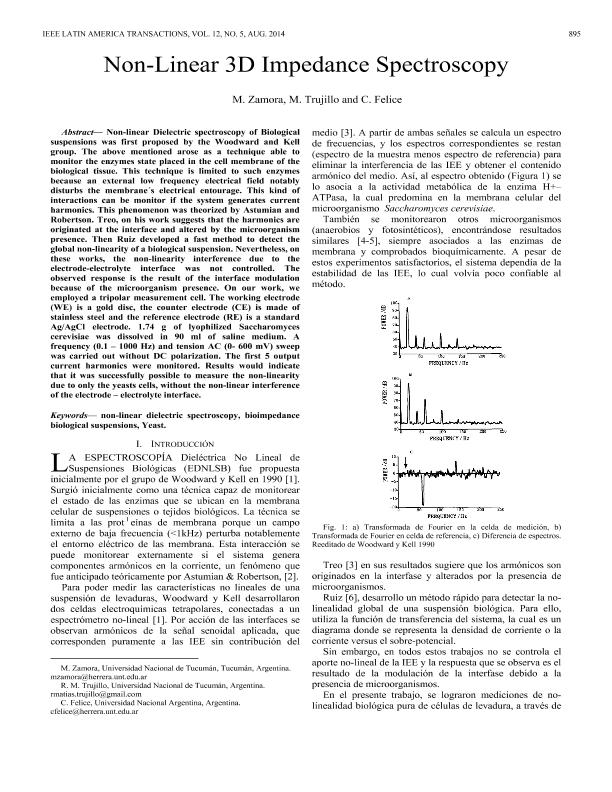Mostrar el registro sencillo del ítem
dc.contributor.author
Zamora, Martín Lucas

dc.contributor.author
Trujillo, Ricardo Matias

dc.contributor.author
Felice, Carmelo Jose

dc.date.available
2017-12-13T20:30:08Z
dc.date.issued
2014-08
dc.identifier.citation
Zamora, Martín Lucas; Trujillo, Ricardo Matias; Felice, Carmelo Jose; Non-Linear 3D Impedance Spectroscopy; Institute of Electrical and Electronics Engineers; IEEE Latin America Transactions; 12; 5; 8-2014; 895-898
dc.identifier.issn
1548-0992
dc.identifier.uri
http://hdl.handle.net/11336/30528
dc.description.abstract
Non-linear Dielectric spectroscopy of Biological suspensions was first proposed by the Woodward and Kell group. The above mentioned arose as a technique able to monitor the enzymes state placed in the cell membrane of the biological tissue. This technique is limited to such enzymes because an external low frequency electrical field notably disturbs the membrane's electrical entourage. This kind of interactions can be monitor if the system generates current harmonics. This phenomenon was theorized by Astumian and Robertson. Treo, on his work suggests that the harmonics are originated at the interface and altered by the microorganism presence. Then Ruiz developed a fast method to detect the global non-linearity of a biological suspension. Nevertheless, on these works, the non-linearity interference due to the electrode-electrolyte interface was not controlled. The observed response is the result of the interface modulation because of the microorganism presence. On our work, we employed a tripolar measurement cell. The working electrode (WE) is a gold disc, the counter electrode (CE) is made of stainless steel and the reference electrode (RE) is a standard Ag/AgCl electrode. 1.74 g of lyophilized Saccharomyces cerevisiae was dissolved in 90 ml of saline medium. A frequency (0.1 - 1000 Hz) and tension AC (0- 600 mV) sweep was carried out without DC polarization. The first 5 output current harmonics were monitored. Results would indicate that it was successfully possible to measure the non-linearity due to only the yeasts cells, without the non-linear interference of the electrode - electrolyte interface.
dc.format
application/pdf
dc.language.iso
eng
dc.publisher
Institute of Electrical and Electronics Engineers

dc.rights
info:eu-repo/semantics/openAccess
dc.rights.uri
https://creativecommons.org/licenses/by-nc-sa/2.5/ar/
dc.subject
Yeast
dc.subject
Bioimpedance
dc.subject
Non Linear
dc.subject
Biological
dc.subject.classification
Biofísica

dc.subject.classification
Ciencias Biológicas

dc.subject.classification
CIENCIAS NATURALES Y EXACTAS

dc.title
Non-Linear 3D Impedance Spectroscopy
dc.type
info:eu-repo/semantics/article
dc.type
info:ar-repo/semantics/artículo
dc.type
info:eu-repo/semantics/publishedVersion
dc.date.updated
2017-12-11T19:23:38Z
dc.journal.volume
12
dc.journal.number
5
dc.journal.pagination
895-898
dc.journal.pais
Estados Unidos

dc.description.fil
Fil: Zamora, Martín Lucas. Universidad Nacional de Tucumán; Argentina. Consejo Nacional de Investigaciones Científicas y Técnicas; Argentina
dc.description.fil
Fil: Trujillo, Ricardo Matias. Universidad Nacional de Tucumán; Argentina. Consejo Nacional de Investigaciones Científicas y Técnicas; Argentina
dc.description.fil
Fil: Felice, Carmelo Jose. Universidad Nacional de Tucumán; Argentina. Consejo Nacional de Investigaciones Científicas y Técnicas; Argentina
dc.journal.title
IEEE Latin America Transactions

dc.relation.alternativeid
info:eu-repo/semantics/altIdentifier/doi/http://dx.doi.org/10.1109/TLA.2014.6872902
dc.relation.alternativeid
info:eu-repo/semantics/altIdentifier/url/http://ieeexplore.ieee.org/document/6872902/
Archivos asociados
